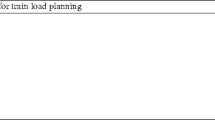Abstract
Singapore Mass Rapid Transit (SMRT) operates two train lines with 83 kilometers of track and 48 stations. A total of 77 trains are in operation during peak hours and 41 during off-peak hours. In this article we report on an optimization based approach to develop a computerized train-operator scheduling system that has been implemented at SMRT. The approach involves a bipartite matching algorithm for the generation of night duties and a tabu search algorithm for the generation of day duties. The system automates the train-operator scheduling process at SMRT and produces favorable schedules in comparison with the manual process. It is also able to handle the multiple objectives inherent in the crew scheduling system. While trying to minimize the system wide crew-related costs, the system is also able to address concern with respect to the number of split duties.
Similar content being viewed by others
References
J.E. Beasley and B. Cao, Dynamic programming based algorithm for crew scheduling, Computers and Operations Research 25 (1998) 567–582.
L. Bodin, B. Golden, A. Assad and M. Ball, Routing and scheduling of vehicles and crews; the state of the art, Computers and Operations Research 10 (1983) 63–211.
A. Caprara, M. Fischetti and P. Toth, A heuristic method for the set covering problem, Operations Research 47 (1999) 730–743.
L. Cavique, C. Rego and I. Themido, Subgraph ejection chains and tabu search for the crew scheduling problem (1997) submitted.
Committee on the Next Decade of Operations Research (CONDOR 1998), Operations research: The next decade, Operations Research 36.
U. Derigs, Solving non-bipartite matching problems vis. shortest path techniques, Annals of Operations Research 13 (1988) 225–261.
M. Desrochers and J.-M. Rousseau, Computer-Aided Transit Scheduling (Springer, Berlin, 1990).
F. Glover, Heuristics for integer programming using surrogate constraints, Decision Sciences 8 (1977) 156–166.
F. Glover and M. Laguna, Tabu Search (Kluwer Academic, 1997).
J.-M. Rousseau, Computer Scheduling of Public Transport 2 (North-Holland, Amsterdam, 1985).
A. Wren, Computer Scheduling of Public Transport: Urban Passenger Vehicle and Crew Scheduling (North-Holland, Amsterdam, 1981).
Author information
Authors and Affiliations
Rights and permissions
About this article
Cite this article
Chew, KL., Pang, J., Liu, Q. et al. An Optimization Based Approach to the Train Operator Scheduling Problem at Singapore MRT. Annals of Operations Research 108, 111–122 (2001). https://doi.org/10.1023/A:1016002910561
Issue Date:
DOI: https://doi.org/10.1023/A:1016002910561




